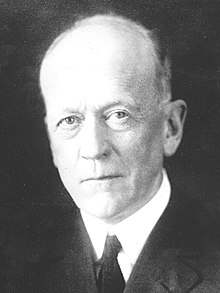Charles D. Walcott
| Charles D. Walcott | |
|---|---|
 |
|
| 4th Secretary of the Smithsonian Institution | |
|
In office 1907–1927 |
|
| Preceded by | Samuel Pierpont Langley |
| Succeeded by | Charles Greeley Abbot |
| 3rd Director of the United States Geological Survey | |
|
In office 1894 – 1907 |
|
| Preceded by | John Wesley Powell |
| Succeeded by | George Otis Smith |
| Personal details | |
| Born | March 31, 1850 New York Mills, New York, USA |
| Died | February 9, 1927 (aged 76) Washington, DC, USA |
| Nationality | United States |
| Known for | Paleontology |
Charles Doolittle Walcott (March 31, 1850 – February 9, 1927) was an American paleontologist, administrator of the Smithsonian Institution from 1907 to 1927, and geologist. He became known for his discovery in 1909 of well-preserved fossils in the Burgess Shale of British Columbia, Canada, see history of the Burgess Shale. He was described by Stephen Jay Gould as "the finest symbol that I have ever encountered for the embodiment of conventional beliefs."
Walcott was born in New York Mills, New York. His grandfather, Benjamin S. Walcott, moved from Rhode Island in 1822. His father, also Charles Doolittle Walcott, died when Charles Jr. was only two. Walcott was the youngest of four children. He was interested in nature from an early age, collecting minerals and bird eggs and, eventually, fossils. He attended various schools in the Utica area but left at the age of eighteen without completing high school, the end of his formal education. His interest in fossils solidified as he became a commercial fossil collector. On January 9, 1872, Walcott married Lura Ann Rust, daughter of the owner of a farm in New York where Walcott made one of his most important trilobite discoveries (Walcott-Rust quarry). She died on January 23, 1876. Walcott's interest in fossils led to his acquaintance with Louis Agassiz of Harvard, who encouraged him to work in the field of paleontology; later that year, he began work as the assistant to the state palaeontologist, James Hall. He lost this job after two years but was soon recruited to the newly formed US Geological Survey as a geological assistant.
Walcott began his professional paleontology career by discovering new localities, such as the Walcott-Rust quarry in upstate New York and the Georgia Plane trilobite beds in Vermont, and by selling specimens to Yale University. In 1876, he became the assistant to James Hall, State Geologist of New York. Walcott also became a member of the American Association for the Advancement of Science.
...
Wikipedia
